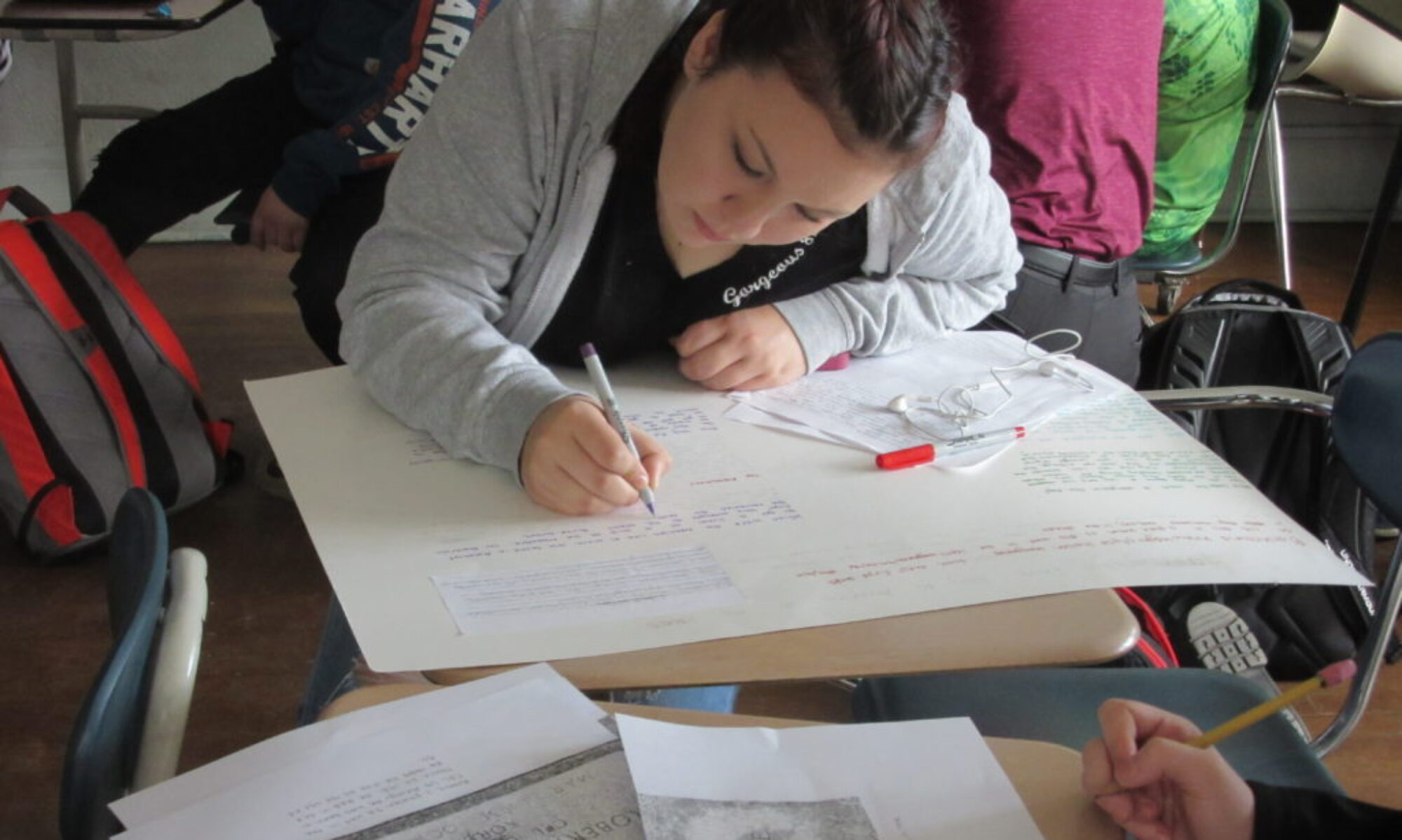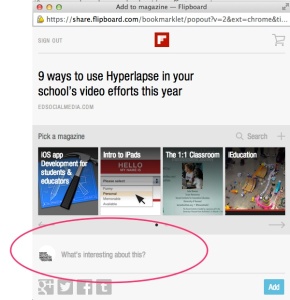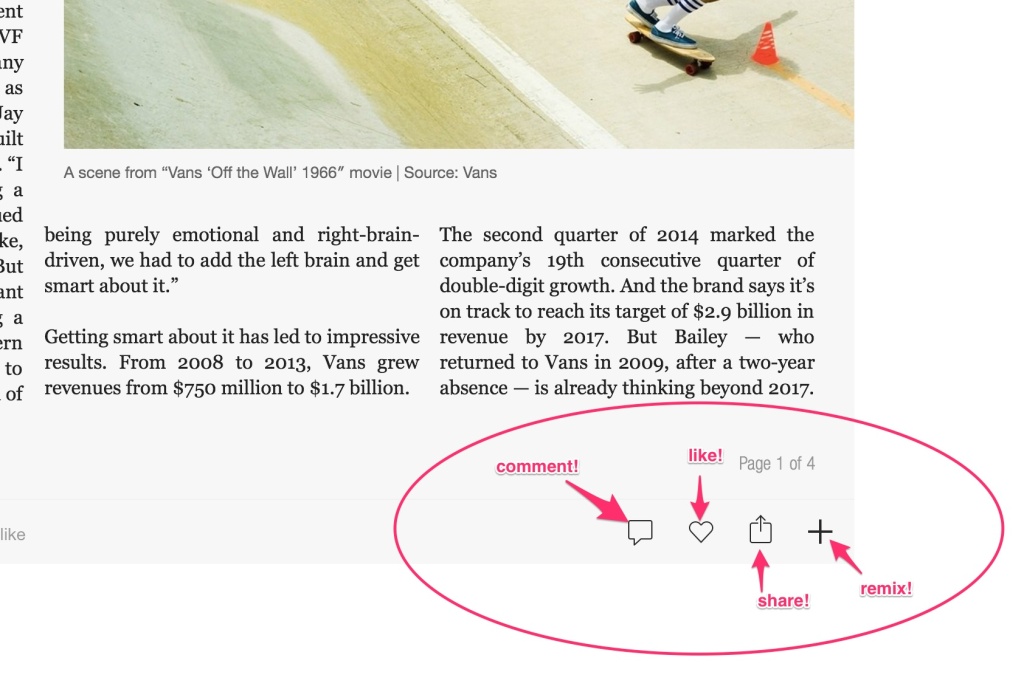We’re flipping for Flipboard — and your students will too!
Flipboard is a free mobile app for the iOS, Android and Google Play tablets that allows you to “flip” content into self-curated magazines. Translation: you grab webpages, videos, tweets or images, and pull them together into magazines.
The magazines are the important bit. Haven’t you ever wanted to helm your own? Even if you haven’t, it’s a sure bet your students have and do. So how can you make Flipboard about learning?
1. Make your students digital magazine publishers
Use Flipboard to harness students’ passion, and give them their own magazine. Flipboard magazines can be (and are) about any kind of topic, which gives your students free reign to explore topics that are personally meaningful.Perfect for PBL! Airships, fashion construction, monster trucks, puffins, azaleas or dinosaurs.
Everyone gets a space to curate, and everyone can subscribe to each other’s magazines. It’s a way students can share content they find meaningful.
But they won’t be doing it in a vaccuum.
2. Provide feedback on their curated collections in the magazine space
When a student flips a piece into their magazine, Flipboard provides a space for them to explain what’s compelling about the content:
Making that piece mandatory for each piece that’s flipped ensures that you, as an educator, have a place to start the conversation.
Then, when you subscribe to the students’ magazines, you have options for interacting with the author of the content:
You (and classmates) can comment on articles, like them, share them (such as to other digital portfolio spaces) or snag the content and remix it into your own magazines. Ask questions about why they chose the content. Ask about their ongoing theme. Provide encouragement when they tell you exactly what they’re finding compelling about their pieces. Dialogue!
3. Let students collaborate on their textbooks
Ever run across a textbook that a) is print-only, b) clocks in at 15lbs and c) was last updated during the Johnson administration? Andrew or Lyndon B, it’s still a crying shame. Flipboard magazines allow for multiple editors, so you can let your class collaborate on writing their own digital, lightweight, up-to-the-moment textbook. And magazines can be either public (share them with families and the community!) or private, and for those of you with classes under age 13, you can set up one Flipboard account in your name, then log everyone into the (private) magazine.
4. Collaborate with your students on a shared (flipped!) digital class space
You can include twitter, tumblr and YouTube feeds in your Flipboard magazines, so the space has a lot of versatility for collecting class content into one shared virtual space. When you think about flipping your classroom, there are a lot of variables at play, but it’s great to choose the most flexible and accessible online space to deliver your assignments (and associated resources to students.
App-smash!
Record a video of yourself giving out the assignment, upload it to Youtube, pull it into your Flipboard along with two or three articles pertaining to the assignment, and ask students to add two of their own, as well as commenting on two collected by other students. Ask if they can locate an appropriate content expert on twitter and pull that feed in as well. During your class discussion, ask students to converse on a Google Doc, then add that Google Doc to the magazine as well. Simply smashing!
Other ideas:
- Have students collaborate on a Flipboard with their community partners for PBL
- Curate your syllabus in a magazine — check out Things AP Econ Students Should Know and Government Class
- Curate a class magazine for families
- Follow other people’s magazines to for current events discussion: how about Egypt After the Revolution, or European Disunion?
Burley Elementary School, in Chicago, has been using Flipboard fairly extensively in their iPad work.





4 ways to use Flipboard in your #flippedclassroom — now with bonus app-smashing! http://t.co/A8F3eVAm03
4 ways to use @Flipboard in your flipped classroom http://t.co/EZpq35Ul0x
RT @innovativeEd: 4 ways to use @Flipboard in your flipped classroom http://t.co/EZpq35Ul0x
4 ways to use Flipboard in your flipped classroom http://t.co/1wW85jcV2e
I use Flipboard to create Learning Summaries in the grad classes I teach. Love the Flip It bookmarks that can be installed on your browser
Excellent! Do your students wind up creating their own Flipboards as part of the classes?
RT @pennybishop: 4 ways to use Flipboard in your flipped classroom http://t.co/1wW85jcV2e
4 ways to use #Flipboard in your flipped #classroom http://t.co/rCB3h9jari #edtech http://t.co/eTlbQto6hn
4 ways to use Flipboard in your flipped classroom http://t.co/Yv5a0X4ZcH #elearning
4 ways to use #Flipboard in your flipped #classroom http://t.co/8iX8zP8zXz #edtech http://t.co/rTGPU0pBju
RT @SpringestUK: 4 ways to use #Flipboard in your flipped #classroom http://t.co/8iX8zP8zXz #edtech http://t.co/rTGPU0pBju